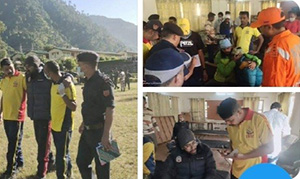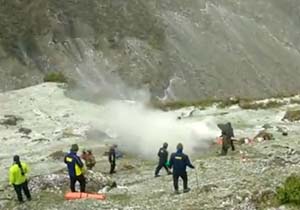DEHRADUN: As many as 74 people were killed in October 2022 in a series of disasters and road accidents in Himalayan state of Uttarakhand, reveals SDC Foundation’s first UDAS Monthly Report for October.
The report has painted a grim picture of disaster management in Uttarakhand for the last 20 years.
According to this report, four major calamities and accidents occurred in the state in October this year in which 74 people died.
The most heart-wrenching tragedy sent shockwaves across Himalaya and the country when 29 mountaineers of Nehru Institute of Mountaineering, Uttarkashi were buried alive in an avalanche on Draupadi ka Danda-2 peak in the district on October 4, 2022.
On October 4, a bus carrying the baraatis met with an accident near Bironkhal in Pauri district that killed 34 people letting loose hell on the ill-fated families and bride and groom.
The helicopter ride for seven tourists from Chennai and Bhawnagar Gujarat cost them their lives after the chopper they were travelling in, crashed near Kedarnath in Rudraprayag district on October 18, 2022.
As it was not enough, four days later on October 22, another 4 people were killed in a landslide at Paingarh village in Chamoli district.
But there were two other disasters in the month of October in the state, but no death was reported.
"But such disasters can prove to be fatal and need to be continuously monitored", said SDC Foundation, a civil society group, working with communities and government agencies, creating awareness about preparedness among stakeholders.
According to reports, on October 1, a major avalanche struck its blow around Chorabari in Kedarnath region.
Although this avalanche did not cause destruction in Kedarnath, but such avalanches sometimes cause major accidents, observed Anoop Nautiyal, president, SDFC.
It should serve as a chilling reminder of the catastrophic Kedarnath tragedy of 2013 that had killed over 6000 people affecting over 4550 villages downstream and other parts of Uttarakhand.
Apart from this, an earthquake of 2.5 magnitude triggered shockwaves in the state on October 2, whose epicenter was in the Barahat range of Bhatwadi tehsil in Uttarkashi district.
Uttarakhand is very sensitive to earthquakes and disasters and mitigation strategy should be put in place, said experts.
The scientists have been continuously expressing the possibility of earthquakes here.
In such a situation, there is a dire need to strengthen the disaster management system Uttarakhand, he said.
He said SDC Foundation will now release reports on major natural calamities and accidents in Uttarakhand every month.
“This will be named as Uttarakhand Disaster and Accident Synopsis (UDAS) Monthly Reports”.
Nautiyal said this report will document the major disasters and accidents occurring in the state throughout the month.
This report will try to compile the major disasters and accidents in the state at one place.
“The report will be mainly based on news published in reliable Hindi and English newspapers and news portals”, he added.
He expressed hope that the UDAS Monthly Report would be helpful to political leaders, policy makers, officials, researchers, educational institutions, civil society organizations as well as media.
He said these reports can be useful for disaster management and in formulation of accident mitigation policies in the state.
Uttarakhand needs to learn from the Oddisha model for disaster management.
The Odisha model has also been appreciated by the United Nations.
The Odisha model offers important lessons on strengthening disaster risk governance, investing in preparedness and scenario planning and spreading greater understanding of disaster risks, Nautiyal said.
The Odisha learnt a hard lesion from the cataclysmic 1999 cyclone that had killed nearly 10,000 people in the state.
But such disaster has never been repeated there since then.
He said that the Uttarakhand government and the disaster management department need to involve all stakeholders.
These include frontline workers like PRI members, ASHA and Anganwadi workers, NGOs and community level volunteers, all government employees, fire services and police personnel in these efforts in order to reduce the loss of life and property due to disaster, said the disaster management experts.






